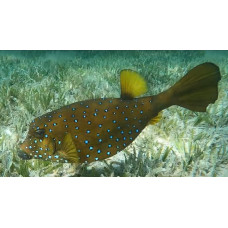Latin name
Ostracion cubicum
Other names
Ostracion cubicum
Identification
They have a cube-shaped body, from which they got their name. The body of the fish is protected, as in other Ostracion, by an exoskeleton, represented by a carapace of fused bony plates. An additional defense mechanism in addition to the shell is the ability of these fish to secrete toxic mucus when in danger.
Features of fish fins
There are no spiny rays on the fins. The dorsal fin has 8-9 soft rays, the anal fin has 9 soft rays, and the caudal fin has 10 rays. The caudal fin increases with age relative to total body size.
Fish colouring
Juveniles are bright yellow with black or dark blue spots; with age, the yellow fades to a dirty mustard and the spots virtually disappear, becoming white with a bluish center. Adults have a bluish coloration with remnants of yellow coloration at the joints between the scales.
Fish from the Red Sea population are slightly different in coloration and are called Ostracion argus, which is considered a junior synonym. A closely related species, Ostracion immaculatus, lives off the southern coast of Japan.
Distribution
Indian and Pacific Oceans - from the Red Sea and east coast of Africa to the Hawaiian and Tuamotu archipelagos. Northern limit of range - Ryukyu Islands, southern limit - Lord Howe Island. Atlantic Ocean - southeastern part along the southern coast of Africa.
Habitat
As a tropical fish, they mainly inhabit lagoons and sheltered reefs, mostly at depths down to 50 m (maximum recorded depth is 280 m). Juveniles usually take refuge in narrow crevices.
Size
Maximum body length up to 45 cm.
Behavior
Benthic pelagic solitary species. Juveniles that have reached the pelagic larval stage migrate to the subtropical zone. Adults are fearful and hide in thick coral when threatened.
Food and feeding habits
The main food is algae, secondary food is microplankton, sponges, mollusks, bottom worms, foraminifera, small crustaceans and fish.
Reproduction
During the breeding season, they form harems consisting of single males and 2-4 females.
Fishing
The species is of no economic importance.
Relationship with a person
Can be bred as an aquarium fish.
| Classification | |
| Phylum | Chordata |
| Class | Actinopterygii |
| Squad | Tetraodontiformes |
| Family | Ostraciidae |
| Genus | Ostracion |
| Species | O. cubicum |
| Features | |
| Conservation status | Not Evaluated |
| Habitat | Pelagic |
| Life span, years | No information |
| Maximum body weight, kg | No information |
| Maximum length, cm | 45 |
| Sailing speed, m/s | No information |
| Threat to people | Not edible |
| Way of eating | Planktonophage |
Yellow boxfish
Tags: yellow boxfish



